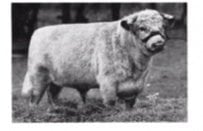The more things change, the more things stay the same. All the noteworthy animals in this thread are noteworthy because of their show records, either as an individual or as a parent. Nothing has changed in 100 years. The praised herds are praised due to their show accomplishments.
Several of my herd bulls trace back to King Collynie, Jr. from the 30's. I absolutely enjoy studying the old cattle magazines. I keep some copies from the 30's and 50's close at hand. It is amazing at the type change from the 30's to the 50's. Some of the cattle in the 30's photos are small framed and early maturing, but the cattle in the 1951 year end Shorthorn World I look through are almost sickeningly small. The straw is heaped to the belly in almost every picture to make them look even shorter legged. Almost everybody is using a Scotch type, imported bull to get them even smaller. The show photos are retouched to show more lower rear quarter and a bushy tail. There almost seems to be a kind of romanticism about these cattle. Some of us more "experienced" breeders lived through this stuff. I don't know of too many that want to go back. I had my fill of 350 pound weaned calves, udders that drug on the ground, steers that finished at 850 pounds. They did have some fleshing ability, but that's about the only positive trait I can remember. And, of course, leading the way through all this was the glorious Angus breed. They were the smallest, blockiest, most popular cattle when I was starting 4-H, so we all had to emulate them. I have a catalog somewhere of the Shadow Isle Angus dispersion from the early 50's. Prince Eric of Sunbeam was their famous herd bull. He was hardly a belt buckle bull to a short man. Of course, then we went to the giraffes of the 80's when we couldn't get them tall enough. The revered Angus again showed the way with their ton-plus junior yearling females in Denver. I do enjoy history and the study of it, I'm just not sure I want to go back there.
Several of my herd bulls trace back to King Collynie, Jr. from the 30's. I absolutely enjoy studying the old cattle magazines. I keep some copies from the 30's and 50's close at hand. It is amazing at the type change from the 30's to the 50's. Some of the cattle in the 30's photos are small framed and early maturing, but the cattle in the 1951 year end Shorthorn World I look through are almost sickeningly small. The straw is heaped to the belly in almost every picture to make them look even shorter legged. Almost everybody is using a Scotch type, imported bull to get them even smaller. The show photos are retouched to show more lower rear quarter and a bushy tail. There almost seems to be a kind of romanticism about these cattle. Some of us more "experienced" breeders lived through this stuff. I don't know of too many that want to go back. I had my fill of 350 pound weaned calves, udders that drug on the ground, steers that finished at 850 pounds. They did have some fleshing ability, but that's about the only positive trait I can remember. And, of course, leading the way through all this was the glorious Angus breed. They were the smallest, blockiest, most popular cattle when I was starting 4-H, so we all had to emulate them. I have a catalog somewhere of the Shadow Isle Angus dispersion from the early 50's. Prince Eric of Sunbeam was their famous herd bull. He was hardly a belt buckle bull to a short man. Of course, then we went to the giraffes of the 80's when we couldn't get them tall enough. The revered Angus again showed the way with their ton-plus junior yearling females in Denver. I do enjoy history and the study of it, I'm just not sure I want to go back there.

